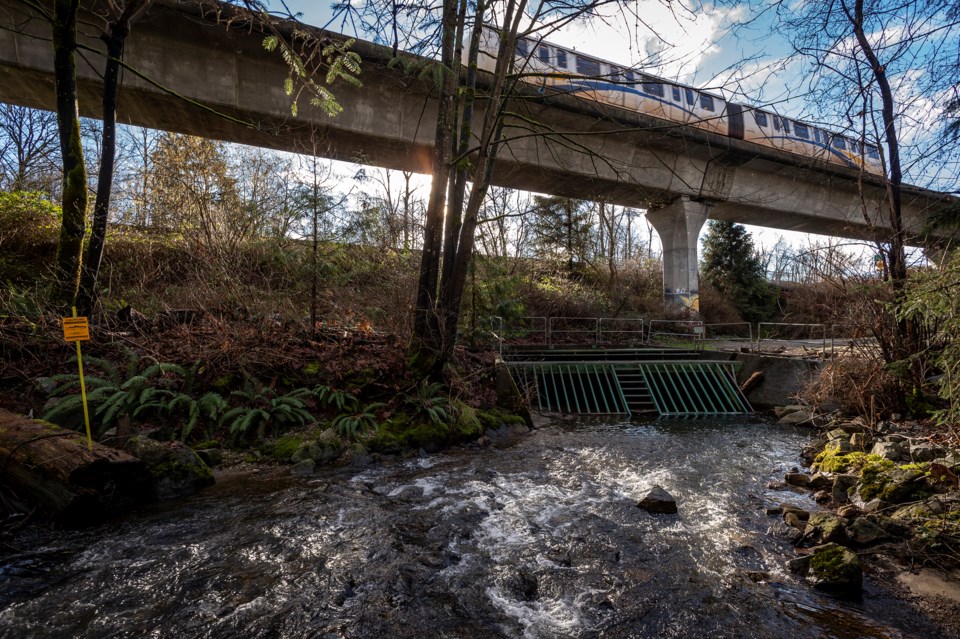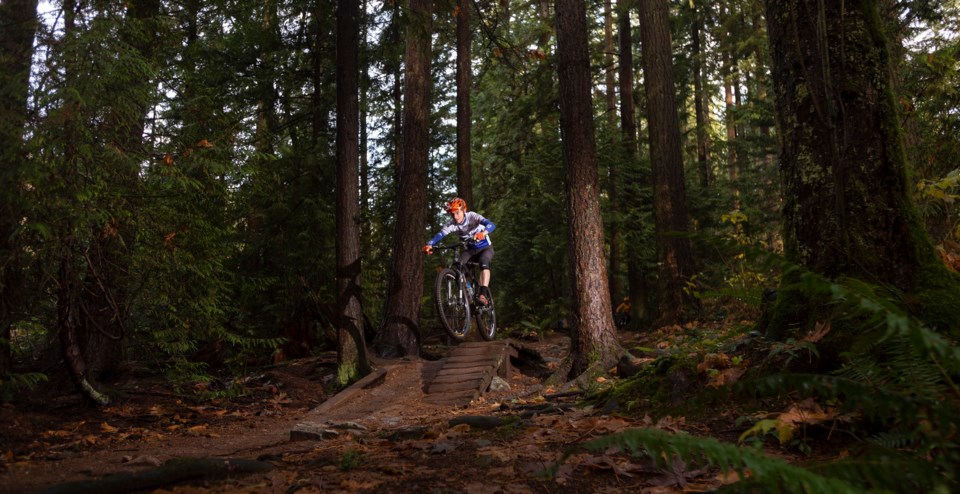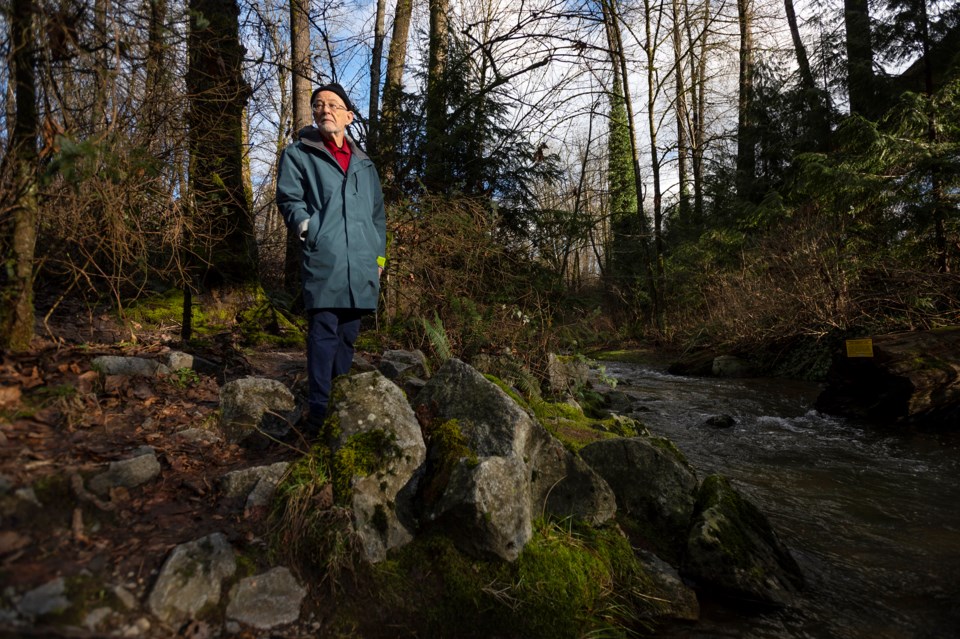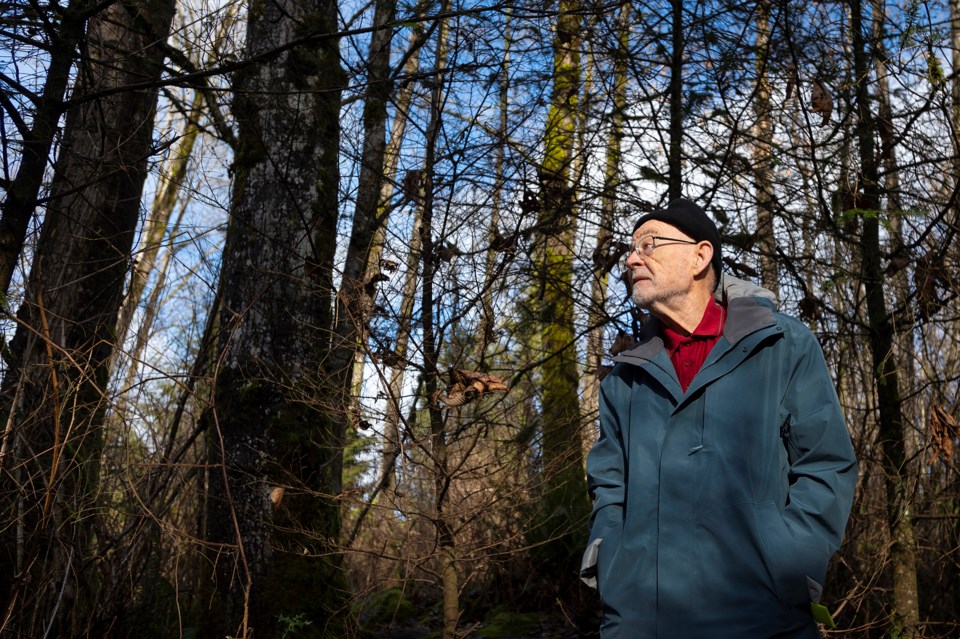With all the developments over the past 70-odd years on Burnaby Mountain, streamkeepers say space has shrunk considerably for sustaining plants and wildlife in the conservation area. And human activities on the trails leave even less space.
In part 3 of this series, we look at the two main competing demands on this mountain – recreation and conservation.
To find the full index of stories in this series, see our Jammed Gears landing page.
The February sun hints at the spring that’s yet to come as Alan James stands at the end of a path along Stoney Creek. Next to him, a slope forms a short frontier between the bustling Lougheed Highway and the trickling creek, part of Burnaby’s network of relatively preserved natural space.
On an app on his phone, he’s tracking the level of salt in the stream, which is believed to have infiltrated the ecosystem through the salting of roads to counter slippery snowfall. The salt eventually washes away and seeps into the groundwater, which feeds Stoney Creek and others that flow from Burnaby Mountain.
Since his retirement from a career as a geophysicist and computer scientist, James has gotten involved with the Stoney Creek Environment Committee as a volunteer, pouring hours of work into the group. While the organization of streamkeepers has a number of activities it does around conserving the stream, James says his passion is for the fish.
James joined the streamkeepers on a whim, signing up to volunteer for a “great salmon sendoff,” in which children from a school released smolt – juvenile salmon at their last stage before adulthood – into the creek.
What hooked James, however, was seeing adult salmon swimming upstream to lay and fertilize their eggs – marvelling at how salmon as long as some of the tributaries are wide were able to navigate the stream to find a home for their yet-to-be-conceived offspring.
But it’s those offspring that are most affected by the road salt, potentially experiencing deformities as a result.
Encroaching city
 Alan James says he's concerned about the effects of human activities and infrastructure on local wildlife in the handful of relatively preserved natural spaces in the city. Photo: Jennifer Gauthier/Burnaby Now
Alan James says he's concerned about the effects of human activities and infrastructure on local wildlife in the handful of relatively preserved natural spaces in the city. Photo: Jennifer Gauthier/Burnaby NowSalt infiltrating the local ecosystem happens to be where James concentrates most of his energy, but it’s also another symptom of his overall concerns about Burnaby Mountain, where Stoney Creek originates.
It’s the decades-long urban creep into what’s left of a sensitive natural setting that has James concerned about the future of the mountain and the natural habitat it provides. Over the past 80-odd years, there have been expanding neighbourhoods, the university, recreation trails, the Trans Mountain pipeline and now the pipeline expansion and a TransLink gondola.
On the pipeline expansion, James says the Stoney Creek Environment Committee membership has been torn between rejecting the pipeline outright and accepting grants previously offered by Kinder Morgan when it owned the pipeline.
The gondola in itself – and any of the other various things that have been built on the mountain – isn’t necessarily bad, James says, but it represents a collective impact of “little, little, little, little things that keep coming.”
“It’s this incremental encroachment on the use of the area. You’re going to get more people up there (on the mountain). You’re going to get more people in the park,” James says. “They have some of the routes that are planned that don’t seem to actually go into the conservation area, but they certainly go across it. And the constant noise is going to drive more of the animals out of there.”
Over time, James says the conservation area has seen “a gradual erosion” since the late 1990s from mountain biking and recreational trails, which he notes have been a selling point for the UniverCity housing development atop the mountain.
The Stoney Creek Environment Committee doesn’t have the resources to study the issue, but James suggests the number of animals living on the mountain has likely significantly declined in the last couple of decades as a result.
Leadership with the Burnaby Mountain Biking Association has regularly attended Stoney Creek Environment Committee meetings, James says, and the two groups have a respectful working relationship. But that doesn’t mean all mountain bikers – or hikers or other recreational trail users – have been as respectful of the trails.
Unauthorized trails
 While the Burnaby Mountain Biking Association works to maintain trails like these, an environmental assessment indicates others have gone off trails, causing erosion on the mountain. Photo: Jennifer Gauthier/Burnaby Now
While the Burnaby Mountain Biking Association works to maintain trails like these, an environmental assessment indicates others have gone off trails, causing erosion on the mountain. Photo: Jennifer Gauthier/Burnaby Now Last year, the city commissioned an environmental assessment on Burnaby Mountain – something Burnaby Mountain Biking Association president Judy Garren says had been mentioned by city staff to her but hadn’t been provided to them. The assessment appears to have played a role in the confusion around the erroneous closure of mountain biking trails last year.
On July 22, city staff put up new maps on Burnaby Mountain that announced the closure of downhill mountain biking trails, incurring a backlash from the local mountain biking community.
In an internal email, obtained through a freedom-of-information request, Ellenwood told the communications department, while saying the closures of trails had not been approved by him, that any changes to the trails – if there are any - will have to come after a review of the Burnaby Mountain assessment.
According to the assessment, obtained by the NOW, erosion generated by park use “is a major issue … requiring on-going maintenance by parks operations staff,” with the “most extreme” erosion in areas “heavily utilized for mountain biking” – especially on the steep black diamond trails. This is most prominently seen in “deep V-shaped trail cross-sections,” which are then exacerbated by hikers and water flow.
But “one of the largest environmental impacts” on Burnaby Mountain is the creation of unauthorized trails by trail users – shortcuts connecting sections of trails and others “often created by mountain bikers to access steep or otherwise challenging terrain.”
Some unauthorized trails are also believed to be created by off-leash dogs, which are required to remain on leash, according to the 1999 Burnaby Mountain management plan. But Garren says those rules don’t appear to be enforced by city staff.
“Unauthorized trails not only have an obvious impact on vegetation (i.e., trampling, removal), they disrupt and degrade wildlife habitat through fragmentation and can contribute to invasive vegetation infestations,” reads the assessment, which estimates 22 unauthorized trails have been created by park users, a “significant management issue for Parks staff.”
Ultimately, the environmental assessment, conducted by Dillon Consulting, recommends the city “develop and enforce a trail master plan for the conservation area which may include recommendations for prohibiting user types, decommissioning unauthorized trails or sections of trails, education campaigns, and seasonal restrictions in sensitive areas.”
Notably, the report does not recommend the city decommission authorized trails as had been erroneously done by the city.
(The full assessment can be found here.)
Finding the right balance
 Alan James says the group he volunteers with, the Stoney Creek Environmental Committee, has worked well with the Burnaby Mountain Biking Association. Photo: Jennifer Gauthie/Burnaby Now
Alan James says the group he volunteers with, the Stoney Creek Environmental Committee, has worked well with the Burnaby Mountain Biking Association. Photo: Jennifer Gauthie/Burnaby NowMountain bikers agree that there needs to be a balance between conservation and recreation. But they don’t believe the current level of mountain biking and trail use – or even adding a few more trails to the mountain – challenges conservation efforts.
“We would like to create more trails. We feel that the need is there. Taking into (account) conservation issues and making sure you’re not going to disrupt the environment, … there are areas on the mountain that don’t have anything at all, and there is space for it, for more trails,” Garren says. “I think the public would be thrilled to have more trails.”
James, on the other hand, disagrees – “I certainly wouldn’t think there should be more” – though he says he couldn’t really speak to where the line should be drawn on the number of trails on the mountain.
“I do know that three or four years ago, they built a new trail,” James says. “We might say we don’t think that’s a good idea, but we get overruled easily.”
At least some city staff appear to agree with James – in internal emails, one staffer wrote that there have been no plans for new trails, saying the mountain “just cannot handle it from a conservation/ecological standpoint.”
Ellenwood, however, appears more open to the question, acknowledging that adding more trails could take some pressure off of other trails and reduce erosion in the harder-hit areas.
At this point, however, the number of trails appears unlikely to change anytime soon. In response to the trail signs incident last summer, the city is launching a review of its 21-year-old Burnaby Mountain management plan, a process that will likely take significant time. And major changes like adding new trails would likely need to wait for that review to be completed.
Ellenwood says the decision, on a staff level, to look at decommissioning trails was done looking only at the environmental assessment. With the reaction that came, he says the new direction for the department is to go at it with a more comprehensive lens, with input from the community and various user groups..
“The world has changed, so I think we have to reassess it and plan better for a balanced use of the mountain, and I think that would be welcomed from all perspectives,” Ellenwood says.
The process is one that will take a fair bit of time, however, since it will involve consulting with the various user groups, with the conservation community and with the city more broadly.
“It will be an engaging process, I can tell you that,” Ellenwood says.
Asked what he would like to see done with a new management plan for the mountain, however, James says he’s less worried about that and more so about the city enforcing its current plan, including banning off-trail riding and forcing dog walkers to use leashes.
“(Dogs are) always off leash. There is no enforcement. We try to get the city to do it, and they say, ‘Oh, we’ll ask the SPCA to do it,’ and you phone the SPCA, and they say, ‘We don’t have anybody to do that,’” James says. “So there’s absolutely no will on the part of parks to do any maintenance other than the trails and very, very little enforcement.”
Ellenwood notes that there have been efforts by the city to curb off-trail use, and the environmental assessment notes an effective way to do that is to erect not just signs but railings around areas of trails where people have tended to go off trail.
In the meantime, the City of Burnaby, the Burnaby Mountain Biking Association and Stoney Creek Environment Committee all agree that the problem of erosion has gotten worse in the last year, as the COVID-19 pandemic has driven people to the outdoors – even resulting in a significant shortage of recreation gear like bicycles.
This has, in turn, caused significantly more damage to the trails that needs to be repaired – work that’s typically done by the mountain biking community through the Burnaby Mountain Biking Association.
But to repair that work, mountain bikers say they need more time to work on the trails.
In the final part of this series, we will look at how the city is seeking to amend its relationship with the mountain biking community, including a promise to increase trail days.
To find the full index of stories in this series, see our Jammed Gears landing page.
Find Dustin Godfrey on Twitter at @dustinrgodfrey



